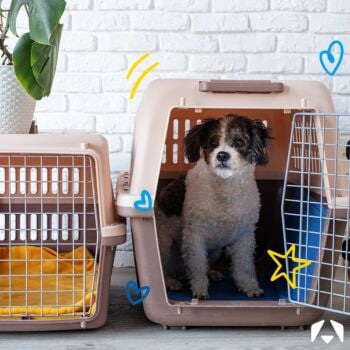English Springer Spaniel
Slightly larger than the English Cocker Spaniel, the English Springer Spaniel was also bred to be a working gundog. Their job was to startle game so that it would ‘spring’ into the air. The Springer Spaniel still proves to be a popular working and family dog. They are even-tempered, intelligent and affectionate.
Like the English Cocker Spaniel, the Springer Spaniel also has ‘Show’ and ‘Field’ strains. The show strain in a Springer Spaniel will have longer ears and coats than their field/working cousins. Both strains will have deep chests and a feathered tail which they hold level with their bodies.
Some pet owners may prefer to keep feathering shorter as this requires less maintenance. Check with the owner how long/short to trim the feathering before grooming
Coat Type
Combination / Silky
Grooming Requirement
Card & Hand-Strip
Pet Grooming Option
Clipper Trim & Card
Grooming Notes
The body and head of a Springer Spaniel can be carded and hand-stripped to encourage the coat to lay tight to the body. Many pet owners prefer for the coat to be clipped, but it is a good idea to card (remove dead undercoat) after clipping, as it promotes better skin health and can help preserve the brilliant colours of the coat.
- Daily brushing is recommended to keep the longer coat tangle free. This also allows the owner an opportunity to remove burrs, twigs and other debris from the longer feathering. Always check ears and paws for debris which could cause discomfort
- Springer Spaniels do tend to shed a little, but not as much as breeds with thick double coats. It can be worthwhile providing a de-shedding treatment in Spring and Autumn when they tend to shed more
- Spaniels have dropped ears which can be prone to ear infections. It’s important to keep the hair beneath the ear flaps dry as this will promote better air circulation for the ear. It’s also important to keep the ear canal dry, so you may opt to ‘plug’ the ear with cotton wool when bathing
Grooming Guide
Prior To Bathing
- Pluck hair from the ear canal as necessary
- Use a blaster to loosen any skin dander, dirt, debris and loose/shedding coat
- Use a rubber curry, undercoat rake, carding tool or bristle brush to remove loose coat
- Brush out any tangles and/or matts from the longer coat or apply intensive conditioner
- Hand-strip/Card the body so the coat lays flat against the body, always working in the direction of coat growth
- Pluck or trim any long downy hair from the head and around the ears so the coat lays flat
After Bathing
Pet Clipper Trim: #7F, #5F, #4F or Short Comb Guides (anything up to ¾ inch). Card coat after clipping.
- Use a damp cloth to go over the muzzle after bathing, wiping away tear stains
- Line brush using a firm slicker, when finished the coat should be tangle free and little/no hair should be being removed. Double check work with a wide toothed comb
- If the dog has a heavier coat, it is acceptable to clip the top skull and cheeks with a #4F – #7F blade
- Clip the top ⅓ of the ear, or to the jawline with a #10 or #15 blade, blend into longer hair
- Neaten edges and the bottom of the ear with thinning/safety scissors
- Clip the muzzle with a #10 or #15 blade if necessary
- Clip edges of lips with a #15 blade
- The throat is left natural or thinned slightly
- Use thinning scissors to trim the cowlick to blend into the shorter areas of the throat
- The front of the front leg should be separate from the chest area. This area should be saddled out to be short and smooth, while the back side of the front legs are well feathered
- The undercarriage should be well feathered and neatened into a soft arch. The highest point of the undercarriage should be below the last rib
- The feathering on the back of the thighs/rear legs should be left long
- Thin the thigh area to accentuate muscle
- The upper side of the tail should be groomed in the same manner as the body of the coat. The underside of the tail should be trimmed with thinning scissors or clipper trimmed
- Shave paw pads with a #15 – #40 blade
- Back brush any excess hair between toes and trim with thinning/safety scissors
- Trim feet and hocks to appear neat with thinning/safety shears
Grooming Tool Recommendations
- Nail Trimmers
- Hemostats (Forceps)
- Clippers
- Rubber Curry
- Pin Brush
- Bristle Brush
- Long Pinned Firm/Medium Slicker
- Dematting Slicker
- Greyhound Comb
- Undercoat Rake (20 Blade)
- De-Shedding Tools
- De-Matting Tools
- Thinning Scissors
- Detailing/Safety Scissors
Other Health Recommendations
Clipper Blade Recommendations
- (Optional) Top Skull & Cheeks – #4F – #7F
- Outside Ear (Top ⅓ ) – #10 or #15
- Inside Ear – #10 – #40
- (Optional) Muzzle – #10 or #15
- Edge of Lips – #15
- Body (Pet Trim) – #7F – #4F or Shorter Comb Guides (up to ¾ inch)
- Paw Pads – #15 – #40
- Hocks & Feet – #4F
Shampoo Recommendations
For everyday use, mild/hypoallergenic shampoos are recommended.
- Mild/Hypo-Allergenic Shampoos
- De-Shedding Shampoos/Treatments
- Deep Cleaning Shampoos
- Silk/Shine Enhancing Shampoos
Conditioner Recommendations
A conditioner is always useful in the longer areas of the coat, to weigh it down and add strength and shine. It can also help protect the coat while brushing





